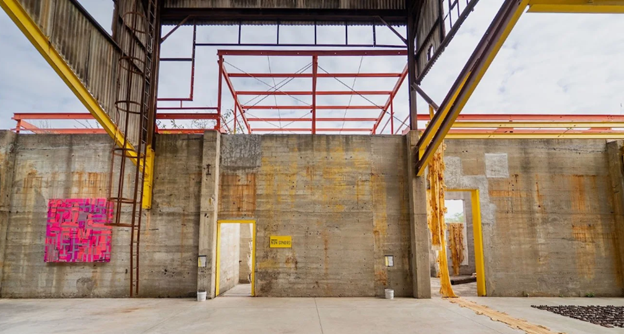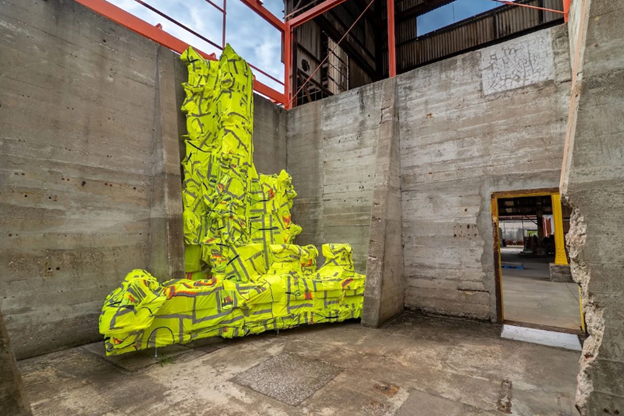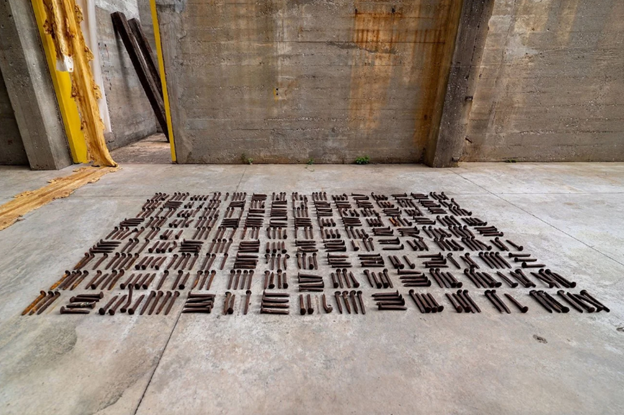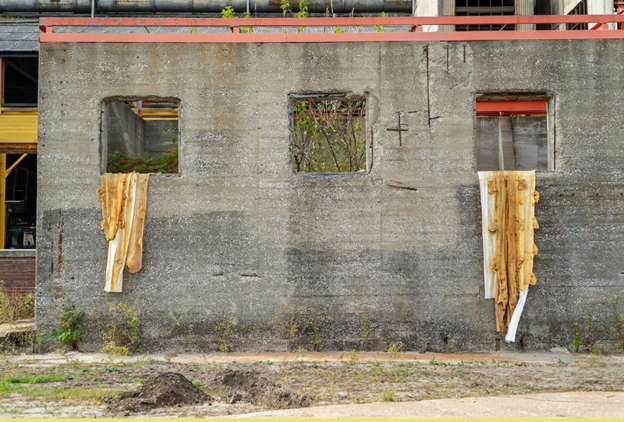Art, Work, and the Invisible at NON STNDRD
By Annette Lepique
Source: Impulse Magazine
In historian Walter Johnson’s 2020 book The Broken Heart of America, Johnson uses the history of the city of St. Louis and its surrounding region to illuminate how capitalism—built upon the extraction of natural resources, worker exploitation, and racial categories—has led to the country’s current economic inequality and strife. St. Louis’s turn, then, from the fabled “Gateway to the West” to a cautionary tale of de-industrialization, hastened by decades of legalized segregation, is the rotten fruit upon the hearth, the mad woman in the attic, what is desperately brushed under the rug of today’s “American Dream.”
On the banks of the Mississippi River, Sauget, Illinois, incorporated as a Monsanto company town in 1926, is less than five miles from downtown St. Louis and the location of the artist-run experimental exhibition site, NON STNDRD. NON STNDRD exists within two large concrete bunkers on the campus of the National Building Arts Center, a unique architectural museum that holds the largest collection of American built environment artifacts in the country and an immense library and archive that encompasses not just architectural and design history, but also the histories of labor, transportation, and the environment that made said artifacts possible.
With exposed roofs that open to the sky, there’s an immediacy and intimacy to this place that speaks directly to the heart of the exhibition A Matter of the Invisible, curated by Pia Singh. Featuring work by Chicago-based artists Jeremiah Hulsebos-Spofford and Leticia Pardo, the show functions like an eddy of the nearby Mississippi: visitors flow through the oft disregarded material conditions of capitalism’s past and present, a journey that in turn opens an expanded sense of possibility for a shared future. The reverberations between the substance, the tactile stuff of Hulsebos-Spofford and Pardo’s work—from worker safety vests to railroad spikes—create a conversation of loops and double backs, tangents and epiphanies that insist upon an honest appraisal of the alienating and lonely noise that dominates life under late capitalism.
[Ed: Leticia Pardo is assistant professor of architecture at the Eskenazi School's J. Irwin Miller Architecture Program and Jeremiah Hulsebos-Spofford is associate professor of fine arts at IU Northwest]
In Hulsebos-Spofford’s Metabolic Drift series, the artist utilizes the idea of a fragmented and unequal global supply chain to reveal the system’s absence and lack, its hallucinatory insistence upon itself, with materials mediated by both manual and digital processes. In the zine that accompanies the exhibition, Singh describes Hulsebos-Spofford’s own chain, the artist’s metaphor made manifest, as beginning with surface scans of architectural objects from the NBAC archives. The scans were then modelled in Chicago and stitched in Gary, Indiana, with materials made in China.
When viewing Hulsebos-Spofford’s Metabolic series, whether it be Metabolic Drift (2025) growing like a neon Tower of Babel upon the bunker’s exhibition wall or Metabolic Drift 4 (2025) aglow like a digital screen upon the concrete, the language available to describe the works begins to slacken, loosen, and ultimately disappear when faced with representations of a cracked and fragile system built upon discordance, upon referents cleaved from their references. Hulsebos-Spofford’s simulacrum of the logics of supply and demand, of worker and boss, and of man and machine, are so eerily spot on that when the alien colors of the artist’s safety vests, now absent of workers’ bodies, are positioned against contrasting lines of grey or punctuating zipper tracks, the undulating strokes are reminiscent of lines of endless code or an AI chatbot spitting up an excess of information. This excess, like the reaching, creeping, ever-encroaching edges of Hulsebos-Spofford’s Drift, is the culmination of data that’s mined, monetized, and pushed further, further, further.
Pardo, in turn, centers the multi-part Palíndromo (2025) on the United States’ dependency upon Mexican labor, specifically focusing on the mid-twentieth-century Bracero Program: an initiative by the federal government in the 1940s which promised many Mexican men short-term work contracts for laying railroad lines or a variety of agricultural labor. However, while the men were promised housing and wages, the program left many of its workers unpaid, abandoned, and exploited. Though the Bracero Program officially ended in the 1960s, its legacy is even more noticeable today as the US continues to rely upon the labor of Mexican workers, all while engaging in mass campaigns of abductions and deportations.
A Matter of the Invisible is on view at NON STNDRD through November 21, 2025.






